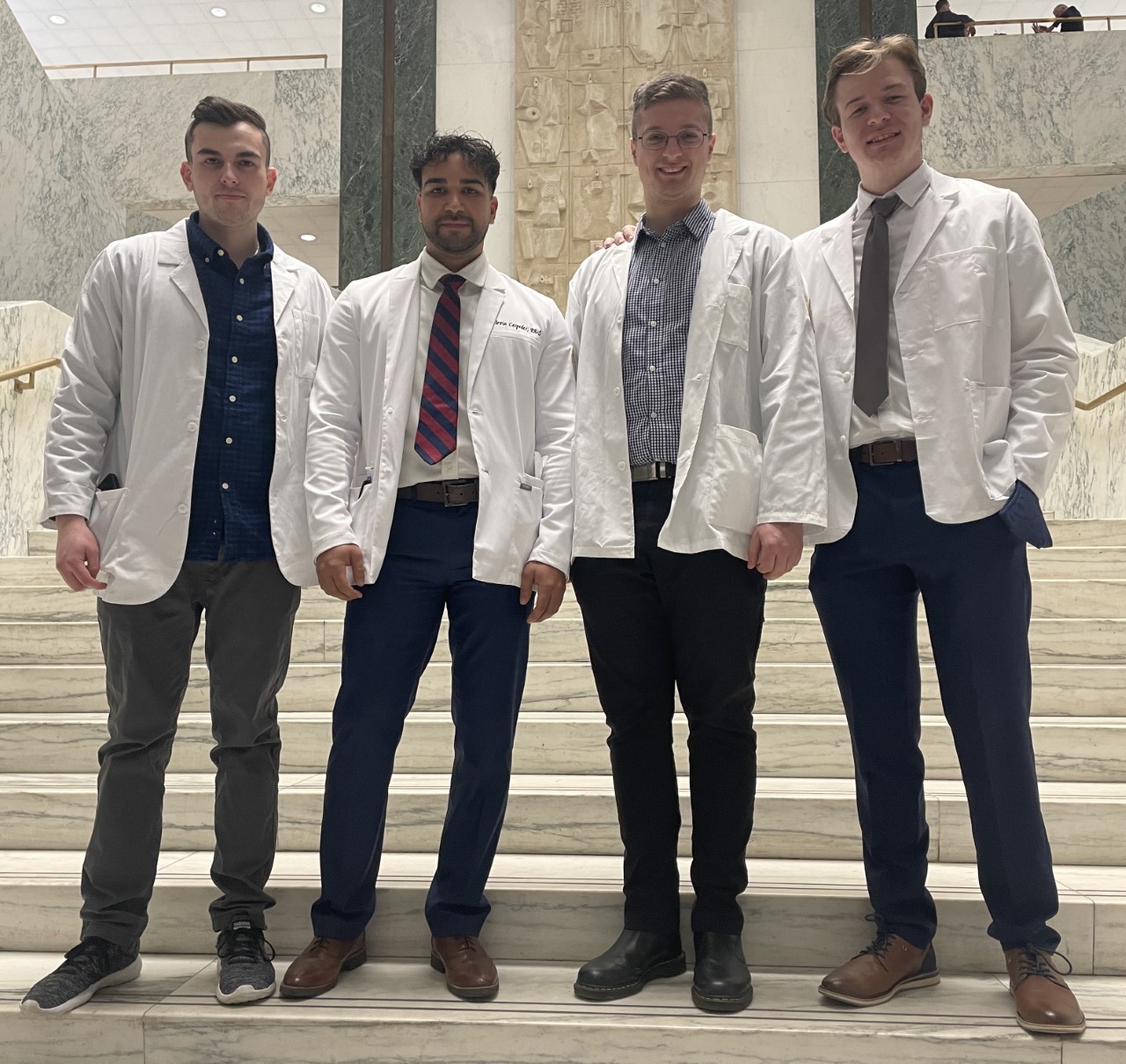 L-r, Physician Assistant Studies students Michael Listro, Irvin Cespedes, Jonathan Lehn and Noah Newlon recently lobbied legislators in the New York state assembly on a pending bill.
L-r, Physician Assistant Studies students Michael Listro, Irvin Cespedes, Jonathan Lehn and Noah Newlon recently lobbied legislators in the New York state assembly on a pending bill.By David DeFusco
Noah Newlon, a student in the Katz School’s M.S. in Physician Assistant Studies, remembers accompanying his younger brother to doctors’ appointments and hospital visits when they were growing up in Cleveland. Noah’s brother Rowen, born with aortic valve stenosis, a condition that obstructs the flow of blood throughout the body, spent much of his childhood under medical observation—an experience that had a profound impact on Noah’s life.
“I always wanted to practice medicine somehow, but now I’m a big cardiology guy,” said Noah. “He and I are really, really close, and I consider myself very lucky to have him in my life.”
That love for his brother is also the reason Noah joined three classmates—Irvin Cespedes, Jonathan Lehn and Michael Listro—in lobbying the New York state legislature as part of a delegation organized by the New York State Society of PAs (NYSSPA) for a bill that would make permanent a state executive order that has allowed physician assistants (P.A.) to practice without a supervising physician since 2020. That order was set to expire in May.
In an aging population, a shortage of doctors has created a demand for care providers like P.A.s who can examine and treat patients, make diagnoses and write prescriptions. They complete thousands of hours of medical training and practice nationwide, improving patient access to high-quality health care in medical and surgical settings. Under current New York state law, P.A.s must practice under a physician’s supervision and are licensed by state boards of medicine.
Jonathan Lehn said the current legislation pending in Albany requires supervision of P.A.s to be continuous, but it doesn’t have to be on site. If P.A.s are working in an emergency room, they don’t always work with the physician they’re assigned. They work with whomever is there and as a team.
“It’s just an administrative burden,” said Lehn, who plans to use his Spanish to help underserved communities when he graduates. “Since the beginning of COVID, P.A.s have practically been working by themselves because of staffing shortages and attrition, and we came through for our patients.”
After graduating from Hunter College, Lehn took a gap year and was a clinical research coordinator at NYU Langone Health, working for a doctor who spoke highly of Fayrose Abodeshisha, a Katz School P.A. industry professor. He also knew Dwayne Williams, another P.A. industry professor, by word of mouth. Williams’ Pance Prep Pearls medical study and review guide is widely used by students aspiring to join the profession.
Of the 20-odd P.A. programs in the area, the Katz School’s faculty reputation was a big seller for Lehn. Like his classmates, Cespedes has always been interested in science and engineering and thought of being a doctor, but he chose to become a P.A. because it would provide more interaction with patients and offers a variety of specialties, including ophthalmology which is his first choice.
The Katz School program’s core clinical rotations include family medicine, primary care, internal medicine, general surgery, emergency medicine, women’s health, pediatrics and behavioral health. Clinical electives cover a wide variety of medical and surgical specialties. Cespedes said advocating on behalf of the profession made it clear to him that being involved in politics is necessary because it dictates the conditions in which he and his classmates will work for their entire career.
“It was vital to have as many people as possible on lobbying day, because it demonstrated to the politicians that this is an important matter and that young people were watching,” he said.
In high school, Michael Listro shadowed a P.A., who is a family friend, at Priority Urgent Care in Connecticut where he eventually got a job as a medical assistant.
“I just kind of fell in love with P.A. on the spot,” said Listro. “I couldn’t be luckier.”
Listro likes that he’s getting a general medical education at the Katz School that will enable him to treat a variety of patients and to make referrals, if necessary, to a specialist.
“It's kind of like a team sport,” he said. “You're interacting with a number of healthcare professionals on a daily basis trying to help someone’s situation get better. It's corny to say, but I want to help people. There are people who need us to look out for them, to take care of them, because not everybody is fortunate to have good health.”
